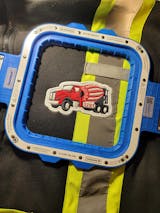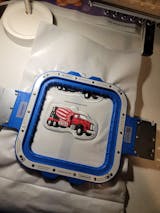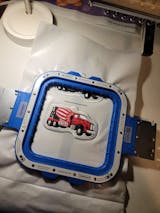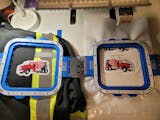1. Introduction: Mastering Gutermann Thread Color Matching
Gutermann threads are the gold standard for sewing and embroidery, trusted by professionals and hobbyists alike for their durability, vibrant color range, and consistent quality. But with hundreds of shades and multiple product lines, achieving perfect color coordination can feel like navigating a maze—especially when your project demands precision.
Whether you’re searching for the ideal hue, deciphering color numbers, or organizing your growing thread stash, mastering Gutermann’s color system is the secret to elevating your creations from “good” to “gorgeous.” In this guide, we’ll unravel the essentials: how to access and use color charts, convert between numbering systems, compare thread types, and implement smart organization strategies.
Ready to take the guesswork out of color matching and let your creativity shine? Let’s dive in.
Table of Contents
- 1. Introduction: Mastering Gutermann Thread Color Matching
- 2. Accessing Gutermann Color Charts: Digital vs. Physical Solutions
- 3. Decoding Gutermann Numbering Systems and Conversions
- 4. Gutermann Thread Types Compared: Mara, Sew-All, Cotton
- 5. Bulk Buying Strategies and Storage Solutions
- 6. Advanced Organization Techniques for Color Consistency
- 7. Conclusion: Building Your Perfect Thread System
- 8. FAQ: Gutermann Color Chart Essentials
2. Accessing Gutermann Color Charts: Digital vs. Physical Solutions
Choosing the right Gutermann thread color isn’t just about picking your favorite shade—it’s about ensuring your stitches sing in harmony with your fabric. With Gutermann’s vast palette, the first step is finding a reliable color chart. Should you go digital, physical, or both? Let’s break down your options.
2.1 Printable PDFs and Digital Tools
Digital resources offer instant access and convenience. Gutermann and suppliers like WAWAK provide free downloadable PDF color charts, letting you browse hundreds of shades from your computer or phone. These digital charts are handy for quick planning, sharing with collaborators, or referencing on the go. Platforms like Etsy even offer customizable trackers in PDF or XLSX formats, making it easy to organize your thread collection or wishlist.
Online color libraries—think Pinterest boards or community-curated lists—showcase vibrant Gutermann options, but beware: digital colors can be deceiving. Screen settings, lighting, and even printer calibration can distort hues, making it risky to rely solely on digital previews for critical projects. Most digital charts focus on popular lines like Mara 100, and may not cover specialty threads or the latest color releases.
Best Practices:
- Use digital charts for initial planning and inventory management.
- Always double-check with a physical sample before committing to a large project.
- Leverage digital conversion charts (like those from WAWAK or GrowYourOwnClothes) to cross-reference retail and wholesale color numbers.
2.2 Physical Charts with Real Thread Swatches
If you crave absolute color accuracy, nothing beats a physical Gutermann color chart. These fold-out booklets—available in 400- or even 700-color versions from retailers like WAWAK, Amazon, and specialty embroidery shops—feature actual thread samples, so you can touch, compare, and match hues directly against your fabric. Many charts include Pantone codes for professional-level cross-referencing and are built to last, with sturdy construction and clear labeling.
Physical charts are especially valuable for bulk buyers, designers, and anyone who needs to match colors across different fabrics or lighting conditions. Expect to invest around $20–$30 for a comprehensive chart, but consider it an essential tool—like a painter’s palette—for anyone serious about their craft.
Key Features:
- Real thread swatches for tactile, true-to-life matching.
- Pantone codes and conversion charts for professional accuracy.
- Available in mini versions at craft stores (Joann, Michaels) for budget-friendly sampling.
2.3 Hybrid Approach for Optimal Matching
Why choose just one method? Many experienced stitchers combine digital convenience with physical precision. Use digital charts and trackers for planning, inventory, and preliminary selection, then verify your choices with a physical swatch before purchasing or starting your project. Mini-charts from craft stores are great for casual users, while full swatch books are a smart investment for professionals or those who frequently sew with a wide color range.
Strategic Recommendations:
| Use Case | Recommended Resource | Cost/Availability |
|---|---|---|
| Professional Projects | 400-Color Physical Chart (WAWAK, Amazon) | $20–$30 |
| Bulk Purchases | Retail-to-Wholesale Conversion Chart (WAWAK) | Free (request via email) |
| Budget-Friendly | Mini Charts (Joann/Michaels), PDFs | $0–$10 (varies) |
For the best results, plan digitally but always confirm physically. Your stitches—and your sanity—will thank you.
3. Decoding Gutermann Numbering Systems and Conversions
Ever fallen in love with a Gutermann color at your local craft store, only to discover the wholesale spool has a completely different number? You're not alone. Gutermann's dual numbering system can be confusing, but with the right tools and a little know-how, you'll never order the wrong shade again.
3.1 Retail vs. Wholesale Color Number Differences
Gutermann threads use distinct numbering systems for retail (small spools) and wholesale (industrial cones or tubes). For example, Retail 010 (Black) corresponds to Wholesale 000, while Retail 275 (Nautical) matches Wholesale 013. This split exists because retail and wholesale products are marketed separately, often with different packaging and quantities.
Conversion charts are your best friend here. WAWAK and GrowYourOwnClothes offer downloadable PDFs that map retail numbers to wholesale equivalents, sometimes including color names for extra clarity. Just remember: not all colors are available in both systems, and some shades may have slightly different names or be exclusive to certain lines.
| Retail Number | Wholesale Number | Color Name |
|---|---|---|
| 010 | 000 | Black |
| 275 | 013 | Nautical |
| 560 | 847 | Spice |
3.2 Step-by-Step Conversion Techniques
1. Identify Your Thread Type: Are you working with retail spools or wholesale cones? Check the packaging or ask your supplier if you're unsure.
2. Use Conversion Charts:
- For retail-to-wholesale, consult paired number lists from WAWAK or third-party PDFs.
- For wholesale-to-retail, look for charts sorted by wholesale numbers.
3. Cross-Check Color Names: Retail and wholesale products may share numbers but have different names (or vice versa). Third-party charts often include both for easier matching.
4. Ask for Help: If you're stuck, suppliers like WAWAK can assist—just provide the number you have, and they'll help you find the equivalent.
Pitfalls to Avoid:
- Regional variations: Some numbers or names differ between countries—always double-check if you're ordering internationally.
- Outdated charts: Gutermann updates its palette periodically, so consult the most recent conversion resources and ensure compatibility with your embroidery design software.
3.3 Managing Discrepancies Across Fabrics and Dye Lots
Color matching isn't just about numbers—fabric type and dye lot can throw curveballs into even the best-laid plans. Metallic threads may look different on stretch mesh than on cotton, and dye lot shifts can subtly alter a shade over time.
Best Practices:
- Use Pantone codes (provided on many physical charts) to standardize color selection across fabrics.
- Always test thread against actual fabric swatches, especially for critical projects.
- For specialty threads (like metallics or silks), consult the latest charts and consider ordering a physical sample before committing.
By mastering Gutermann's numbering systems and conversion techniques—and staying vigilant about fabric and dye lot variables—you'll ensure your projects are always stitched in perfect harmony.
4. Gutermann Thread Types Compared: Mara, Sew-All, Cotton
When it comes to Gutermann, not all threads are created equal—and that’s exactly what makes their range so versatile. Whether you’re a professional embroiderer, a quilter, or just someone who loves the hum of a sewing machine, understanding the differences between Mara, Sew-All, and Cotton threads is your ticket to flawless results. Let’s unravel the details.
4.1 Material Properties and Project Suitability
Gutermann’s lineup covers the spectrum from industrial strength to delicate detail, thanks to their thoughtful material choices and technology.
Mara Thread- Material: Polyester
- Technology: Micro Core Technology, which means enhanced strength, abrasion resistance, and minimal lint—think of it as the “sports car” of sewing threads.
- Weight Range: From featherlight Tex 13 (Mara 220) to ultra-heavy Tex 400 (Mara 8), including options like Mara 100 (Tex 30), Mara 70 (Tex 40), and Mara 50 (Tex 60).
- Color Range: 400+ colors, all displayed in the comprehensive 400-Color Thread Chart with real thread swatches for true-to-life matching.
-
Best For:
- Lightweight (Mara 220/150): Fine seams, lingerie, swimwear
- Medium (Mara 100/70): General sewing, home textiles
- Heavy-duty (Mara 50/35/30): Leather, upholstery, topstitching
- Extra-heavy (Mara 15/11/8): Tents, suitcases, industrial gear
- Material: Polyester
- Features: Smooth finish, flexible enough for cotton, denim, and stretch fabrics.
- Color Range: 400+ shades, optimized for machine embroidery and everyday sewing.
-
Best For:
- General garment sewing
- Home décor
- Machine embroidery (minimal thread breakage, smooth performance)
- Material: 100% natural cotton
- Features: Soft, matte finish—perfect for those who crave an organic touch.
- Color Range: More limited than Mara or Sew-All, but covers the classics for traditional projects.
-
Best For:
- Quilting (natural texture, precise stitch alignment)
- Hand embroidery (non-stretch for accuracy)
| Feature | Mara | Sew-All | Cotton |
|---|---|---|---|
| Material | Polyester | Polyester | 100% Cotton |
| Weight Range | Tex 13–400 (multiple weights) | Medium-weight | Medium-weight |
| Color Options | 400+ colors | 400+ colors | Limited range |
| Best For | All-purpose, heavy-duty, leatherwork | General sewing, embroidery | Quilting, hand embroidery |
| Strength | High (abrasion-resistant) | Moderate | Lower (natural fiber) |
| Luster | Silk-like sheen | Smooth finish | Matte, soft appearance |
Key Takeaways:
- Mara’s broad weight and color range make it a true chameleon—ideal for everything from delicate lingerie to industrial applications requiring commercial embroidery equipment.
- Sew-All is your go-to for versatility and reliability, especially in high-volume or machine embroidery projects.
- Cotton’s natural feel and non-stretch properties shine in quilting and hand embroidery, where tradition and texture matter.
For precise color matching, always consult the Gutermann 400-Color Thread Chart or Pantone codes included with Mara threads. It’s like having a secret decoder ring for perfect projects.
4.2 Color Range Implications for Specific Techniques
Thread isn’t just about holding fabric together—it’s about making your work sing. The type you choose can make or break your technique.
- Machine Embroidery: Sew-All’s smooth polyester finish and vast color palette are engineered for machine embroidery. Its flexibility and minimal breakage mean fewer interruptions and more consistent results, even on stretch fabrics.
- Quilting: Cotton thread’s soft, matte finish integrates seamlessly with natural-fiber fabrics, making it a staple for quilters who want their stitches to blend rather than shine.
- Heavy-Duty Applications: Mara 50 (Tex 60) and heavier weights are the unsung heroes for leather, upholstery, and outdoor gear. Their strength and abrasion resistance handle stress without snapping—a must for topstitching, buttonholes, and anything that takes a beating.
- Specialty Threads: Gutermann also offers metallics and other specialty threads, perfect for decorative embroidery or adding a touch of luxury. These require careful handling and sometimes a tweak in machine tension, but the results are worth it.
Pro Tip: When planning a project, match your thread type to both the fabric and the intended use. For high-stress seams, opt for Mara’s heavier weights. For intricate embroidery, Sew-All’s smoothness is your friend. For heirloom quilts, nothing beats the authenticity of cotton.
5. Bulk Buying Strategies and Storage Solutions
Let’s face it: once you fall in love with Gutermann threads, your stash will multiply faster than you can say "color chart." But buying in bulk and keeping your collection organized doesn’t have to be overwhelming—or expensive.
5.1 Maximizing Savings with Quantity Discounts
Bulk buying isn’t just for factories—savvy home stitchers and small studios can reap the rewards, too.
- Tiered Pricing: Retailers like Rito.com and WAWAK offer significant discounts when you purchase multiple units. For example, buying 3 units can net you a 22% discount, while 5 units can bring savings up to 26%. Wholesale platforms like SupplyLeader offer even deeper bulk rates, sometimes with custom branding and door-to-door shipping.
- Cost per Yard: The math doesn’t lie: a 100m retail spool may cost the same as a 1000m wholesale cone, giving you nearly ten times the thread for your money. Even after factoring in shipping, wholesale orders usually deliver more yards per dollar.
- Using Color Charts for Smart Selection: The Gutermann 400-Color Thread Chart is your best friend here. Use it to identify high-use colors—think black, white, gray, and your personal favorites—then buy those in bulk. For less common shades, smaller quantities or curated packs can fill the gaps.
- Strategic Sourcing:
- WAWAK and similar suppliers sell Mara 100 (Tex 30) in large spools, slashing per-unit costs.
- Look for loyalty programs and monitor seasonal embroidery machines on sale events or direct manufacturer deals for additional savings on orders over 50 yards.
- Long-Term Planning: Use digital or printable charts to plan future projects and avoid last-minute, full-price purchases. Conditioning your thread can also extend its life and reduce waste.
| Thread Type | Bulk Price Example | Bulk Discount | Source |
|---|---|---|---|
| Sew-All 100m (30-pack) | $63.50 | 26% off for 5+ | Rito.com, WAWAK |
| Cotton 250m | $9.95 | N/A | WAWAK |
| Maraflex Elastic 150m | $6.85 | N/A | WAWAK |
| Extra Strong 100m (5-pack) | $18.79 | 10% off for 5+ | WAWAK |
| Challenge | Solution |
|---|---|
| Color consistency across suppliers | Use physical swatches and conversion charts |
| High upfront bulk costs | Prioritize high-usage threads with tiered discounts |
| Obsolete color charts | Verify chart editions for the latest shades |
Bulk buying, when paired with smart color chart usage, is like having a well-stocked pantry—always ready for your next creative craving.
5.2 Organizing Large Spools and Maintaining Accessibility
A rainbow of giant spools can quickly turn into chaos—unless you have a plan.
- Pegboards & Adjustable Racks: Mounting spools vertically on pegboards or thread racks keeps them tangle-free and easy to spot. Adjustable drawer organizers or clear plastic bins with compartments protect threads from dust and make it easy to group by color.
- Cabinet and Drawer Systems: Dedicated cabinets or drawer dividers let you sort by color family or thread type. See-through containers mean you can identify shades at a glance—no more rummaging.
- Labeling: For older spools without built-in labels, write the color number on a sticker or directly on the spool with a fine-point marker. This tip, echoed by the PatternReview community, saves endless frustration when you need to restock or match a shade.
- Color-Coded Storage: Organize by color family (neutrals, blues, greens, etc.) to mirror the Gutermann chart’s structure. This makes selecting the right thread a breeze.
- Sewtalent Magnetic Hoops: Efficient garment embroidery tools like Sewtalent magnetic hoops help free up precious workspace. By streamlining the hooping process, you’ll have more room (and sanity) to keep your thread collection neat and accessible.
Pro Tip: For spools prone to unraveling, use clear elastic bands or specialty products like Hugo’s Amazing Tape to tame loose ends. Store matching bobbins with their spools using small wire ties or bobbin clips.
A well-organized thread stash isn’t just pretty—it’s a productivity powerhouse.
6. Advanced Organization Techniques for Color Consistency
When your projects demand perfection, a little organization goes a long way. Here’s how to keep your Gutermann colors consistent, your inventory under control, and your creativity flowing.
6.1 Leveraging Pantone Codes and Physical Swatches
Gutermann’s color charts don’t just look pretty—they’re packed with practical power.
- Pantone Codes: Each Gutermann shade is assigned a Pantone code, making it easy to match threads across different fabrics and materials (think Power Net, Satin Strap Elastic, or even plush underwire casing). Cross-referencing with Pantone Fashion, Home + Interiors guides ensures your thread and fabric are in perfect harmony.
- Physical Swatch Verification: Digital previews are convenient, but nothing beats comparing real thread swatches to your fabric. The 400-Color Thread Chart includes actual thread samples, so you can assess color, texture, and sheen directly—no more surprises when you start stitching. Available at craft stores (Joann, Michaels) or through embroidery hoop Walmart online listings.
- Cross-Fabric Matching: For projects that mix materials, use physical swatches to check for color shifts under different lighting or on varying textures.
Action Step: Always verify your thread choice with a physical swatch before starting a major project. It’s the difference between “almost right” and “absolutely perfect.”
6.2 Digital Tracking and Labeling Systems
In the age of spreadsheets and apps, your thread stash can be as organized as your playlist.
- Inventory Management: Use spreadsheets or dedicated apps to log thread quantities, color numbers, and project associations. This digital backup prevents accidental re-purchases and helps you plan for future needs.
- Labeling: Mark spools with color numbers and names—Sharpies work wonders on plastic. For bobbins, store them alongside their matching spools or use small containers with dividers.
- Color-Coded Storage: Sort threads by color family or project type in clear bins or drawer organizers. Pre-curated thread packs (like “Best Sellers” or “Earth Tones”) streamline inventory building.
- Community Tips: PatternReview users recommend keeping a “thread book”—a notebook with thread samples and numbers for quick reference. Assign color codes to design elements in your projects to avoid mid-project mismatches.
- Sewtalent Magnetic Hoops: Stable fabric tension from Sewtalent hoops minimizes thread breaks during embroidery, making it easier to track and manage your threads without the headache of constant rethreading or color confusion.
Pro Tip: For high-stress projects, opt for industrial threads (like Mara 70/30) to reduce breakage and ensure color consistency throughout.
By combining physical swatch verification with digital tracking and smart storage, you’ll never lose track of your favorite Gutermann shades—or your creative momentum.
7. Conclusion: Building Your Perfect Thread System
Building your ideal Gutermann thread system is about more than just collecting colors—it's about creating a workflow that brings your creative vision to life with precision and ease. The most successful stitchers consistently rely on physical color charts for true-to-life accuracy, using them as their north star for every project. Mastering the conversion between retail and wholesale numbering systems ensures you never end up with the wrong shade, no matter where you shop. By aligning your thread types—Mara, Sew-All, Cotton, and specialty lines—to each unique project, you guarantee both beauty and durability in your results. And don’t underestimate the power of bulk buying and smart organization: investing in high-use colors and maintaining a well-labeled, accessible stash will save you time, money, and frustration. Start by focusing on the colors you use most, and let your system grow alongside your skills. With these strategies, your stitches will always sing in perfect harmony.
8. FAQ: Gutermann Color Chart Essentials
8.1 Q: Where can I buy a physical Gutermann thread color chart?
A: You can purchase physical Gutermann color charts with real thread swatches from suppliers like WAWAK, Amazon, and specialty embroidery shops that may also offer embroidery machine repairs near me services. These charts come in versions displaying 400 or even 700 colors and are typically priced between $20–$30. Mini-charts with popular shades are sometimes available at craft stores like Joann or Michaels.
8.2 Q: Are digital Gutermann color charts accurate for color matching?
A: Digital color charts are incredibly convenient for planning and inventory, but they aren’t 100% reliable for precise color matching due to variations in screen settings and printer calibration. For the most accurate results, always verify your choices with a physical chart featuring real thread samples.
8.3 Q: What’s the difference between Gutermann Sew-All and Cotton threads?
A: Sew-All is a polyester thread known for its strength, slight stretch, and versatility across all fabrics—making it ideal for both general sewing and machine embroidery. Cotton thread, made from 100% natural fibers, offers a soft, matte finish and is favored for quilting and hand embroidery where a traditional look and non-stretch properties are desired.
8.4 Q: Can Gutermann threads be used for machine embroidery?
A: Absolutely! Gutermann Sew-All, Mara, and Metallic threads all perform well in embroidery machines. Just be sure to adjust your machine settings if you’re working with specialty threads like metallics, as they may require a bit of tension tweaking for best results.
8.5 Q: How do I handle regional number variations and convert between retail and wholesale Gutermann thread numbers?
A: Gutermann uses different numbering systems for retail (small spools) and wholesale (industrial cones). Conversion charts—available from WAWAK, GrowYourOwnClothes, and other online resources—make it easy to match colors across systems. Always double-check your chart’s edition and, when in doubt, consult your supplier for assistance.
8.6 Q: What’s the best way to organize and track my Gutermann threads?
A: Many stitchers use a combination of physical swatch books, digital spreadsheets or apps, and clear labeling on spools and bobbins. Some keep a “thread book” with samples and numbers for quick reference, while others store matching bobbins with their spools using elastic bands or bobbin clips. Color-coded storage and regular inventory updates help prevent mismatches and accidental re-purchases.
With these answers at your fingertips, you’re ready to navigate the colorful world of Gutermann threads with confidence and creativity. Happy stitching!







